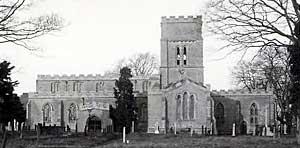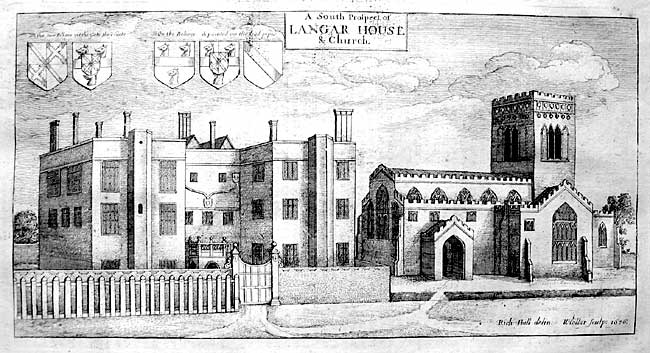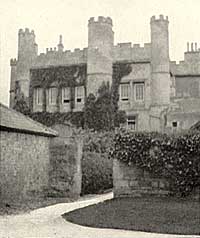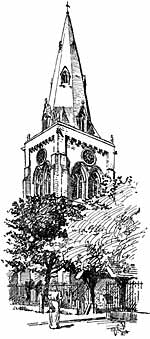Langar, Wiverton Hall, and Bingham
 Langar Church.
Langar Church.A picturesque drive led from Whatton to Langar, where the party were met by the Rev. H. H. Wood, the rector. The nave arcades of this Church are Early English, the lobated capital at the east end of the south arcade being worthy of special attention. Containing the memorials of three important families, it may almost be described as a place of tombs, for "storied urn and animated bust" are to be seen on every hand. The transept on the south side is full of monuments to the Howes, and their predecessors, the Scropes, while the north transept is equally full of memorials of the Chaworths, the ancient owners of Wiverton, whose mansion stood in the vale below Langar, in sight of the sacred edifice. It was in this church that the remains of the Admiral Earl Howe were interred, in August, 1799, in the presence of a great multitude of people. The hero of the glorious "First of June," who shattered the French fleet, causing its admiral to "leave half his dismasted ships behind him," was buried in the family vault, by the side of his brother, the Hon. Thomas Howe, the coffin plate bearing the following inscription:— "Richard Howe, Earl and Viscount Howe, Viscount Howe and Baron Clenarley in Ireland, Admiral of the Fleet, General of his Majesty's Marine Forces, and Knight of the Most Noble Order of the Garter, died 5th August, 1799, aged 73 years." The arched vault of brick was built by the first Mr. Howe, of Langar, for a burying place, and extends several feet high from the south transept into the body of the Church. In the transept are the words "Entrance to the Vault," and on the west wall, a little distance away, is a plain tablet of marble to the famous admiral, surmounted by a coat of arms. The rector pointed out some of the principal monuments, especially in the Chaworth transept, and attention was directed to the oak screens of the transepts, and to the Jacobean work of the pulpit, and some of the pews. The Chaworth Monuments are three in number, and commemorate:—
(1) Sir George Chaworth, Knt., who died 22nd September, 1521, and Katherine, his first wife, who died I2th October, 1517.
(2) Sir John Chaworth, Knt., son of the above, who died 3rd September, 1558. He had no issue by his first wife, but fourteen children by his second.
(3) Sir George Chaworth, Knt., son of the last, who died 4th March, 1589, leaving an only daughter.

Langar Hall and church in 1676.
Time did not permit a visit to the site of the old hall, which was sold by the admiral's successor to John Wright, Esq., whose son took down the building, which adjoined the Church, and divided the park into fields. When Leland visited it in 1540 he described it as "a large stone house, embattled like a castle." Before the time of the Howes it was the abode of the Lords Scrope, and the party inspected and admired the stately tomb in the south transept of the Church to Thomas Lord Scroope, Baron of Bolton and Masham, Knight of the most noble Order of the Garter, who died 2nd September, 1609, and commemorating also his wife and son. The effigies are underneath a canopy, whereon are their arms, with quarterings, the canopy being supported by tall pillars of black marble. A descendant of the Scropes married John Howe, and in this way the parish became connected with a family which gave to England the famous Earl Howe.
 Wiverton Hall.
Wiverton Hall.From Langar the party drove into the vale, and drawing up in front of Wiverton Hall, were received by Mrs. Chaworth Musters, She had displayed in her drawing-room many curiosities, notably a magnificent illuminated pedigree of the Chaworths, on vellum, and a beautiful miniature of Mary Chaworth, with Byron's manuscript of the well-known verse above it :—
"Hills of Annesley, bleak and barren,
Where my thoughtless childhood strayed.
How the northern tempests warring
Howl above thy tufted shade.
Now no more the hours beguiling
Former favourite haunts I see;
Now no more my Mary smiling
Makes ye seem a Heaven to me."
Mary Chaworth married John Musters, of Colwick, in 1805, and died in 1832. Mrs. Musters also showed a strong box, from Newark Castle, with a ponderous lock, a sword, once hanging in Langar Church, an old iron kettle-stand, from Annesley, several Chaworth portraits, and other articles of interest.
After inspecting these curiosities, the visitors were shown through the house, attention being specially drawn to a parlour in the ancient gatehouse, in front of which the present modern mansion was built. Going through the grounds the remains of a moated enclosure in the wood adjoining the house was pointed out. Mr. Stevenson expressed his opinion that this was the site of the pre-Norman manor house.
 Bingham Steeple.
Bingham Steeple.The last place on the list was Bingham, and after tea at the "Chesterfield Arms," the rector, the Rev. P. H. Droosten, met the party at the Church. He pointed out to the visitors some of the characteristic features of the Church, which is in the Early Decorated style, and dates probably from the earlier half of the fourteenth century. The Church is cruciform, consisting of nave and aisles, north transept, south transept and chantry chapel, and chancel. The arcade of the northern aisle has capitals carved in a severely conventional style, the most curious of them being the third, which has masks and faces at the angles of the octagon, believed to represent the seven mortal sins, one of them being repeated, to adapt the number to the form of the capital. On the south side the capitals are very natural and realistic, the second nearest the south porch representing foliage blown right and left, as if caught in a draught from the doorway striking upon the pillar. There are instances of water trough mouldings in the bases of pillars upon both sides of the Church. The chantry contains a recumbent cross-legged effigy, said to be the tomb of Sir Richard de Bingham, carved in Caen stone, and the broken fragments of a marble effigy of later date.
The tower, which is of earlier design than the Church, has a noticable feature in the deep embrasure of a lancet window, which is heightened in effectiveness by being pierced through a buttress. At the west and south-west angles of the exterior of the Tower are two figures, now headless, which condition is locally assigned to the soldiers of Oliver Cromwell. They are said to represent two of the Evangelists, and are deserving of especial remark from the fact that they are vested in the Eucharistic vestments of a Bishop, very clearly carved. This Early English tower and the decorated spire were much admired.
